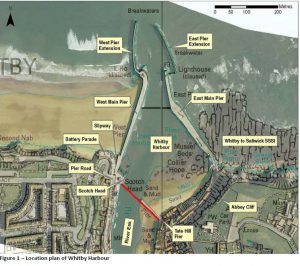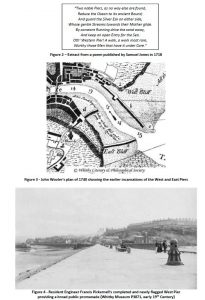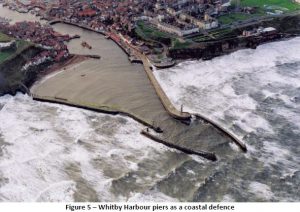The Whitby Piers Coast Protection Scheme involved the £6.76m capital refurbishment of Whitby Harbour’s famous West and East Main Piers, improving the condition of these Grade II listed structures into the foreseeable future.
Whitby Harbour is located on the North Yorkshire coast, at the mouth of the River Esk estuary (Figure 1). It is presently a functional fishing harbour that supports a local maritime industry. Also, it has a picturesque setting, complimented with the iconic Whitby Abbey set atop the adjacent rugged cliffs, and significant cultural, geological, environmental and heritage interest.
The harbour is vital in supporting a major tourism industry in Whitby.

Some form of harbour has been present at this location for over 800 years, and the history of its development is well recorded
(Figures 2, 3 and 4).

The Main Piers at Whitby Harbour provide critical coastal erosion defence and sea flooding protection to the town (as shown in
Figure 5). However, with both structures in a poor structural condition, exhibiting a significant number of defects such as toe
undercutting, block settlement, and voiding, capital works were required to refurbish the structures.

The objectives of the project were:
- To extend the life of the existing Main Piers as coastal defence assets as far as is economically practical;
- In doing so, to better protect assets totalling £128,082k in net present value, from coastal erosion and sea flooding risks,
including 161 commercial properties and 336 residential properties, many of which fall within the UK’s 20% most deprived indices; - To reduce future maintenance requirements of the Main Piers;
- To reduce the risk of sea flooding along the harbourside Pier Road from the waves running up the slipway adjacent to the West Pier, at Battery Parade (see Figure 1); and
- To improve public safety whilst people are using the Main Piers.
Through early consultation with the Local Planning Authority’s Conservation Officer and Historic England, a solution was designed which not only minimised any potential impacts associated with the scheme on the Grade II Listed status of the Main Piers and wider Whitby Conservation Area, but also provided a number of positive contributions to the character and local
distinctiveness of the piers. Overall, the history of the piers shows how they have continuously been altered and repaired since they were first constructed in the early 18th century and the latest refurbishment works, completed in November 2019, represent the latest progression in the life of the piers, safeguarding them into the foreseeable future.

The project stabilised sandstone facing blocks of the piers, filled voids using concrete, and repaired the deck surface to prevent damage from water ingress during wave overtopping. A new flood deflector wall at the adjoining Battery Parade slipway was built in preference to a more visually intrusive flood gate, and this wall now lessens the impact of wave run-up on the slipway during high tides and stormy sea conditions, protecting a number of commercial properties against sea flooding which previously regularly occurred.
The construction work, susceptible to unpredictable weather and undertaken in a hostile marine environment, was carried out from marine craft, cranes with suspended access systems, and divers, all working in tidal conditions. Through careful planning and coordination, construction was completed safely, five weeks ahead of programme and £150k under budget, with the design, construction methods and materials used being sympathetic to heritage status of the structures.
Drone footage of the scheme is available to view at the following link: https://youtu.be/hsBZuczOlIQ
Key achievements
- Design and materials sympathetic to Grade II listed status of the structures.
- Minimised potential impacts on heritage whilst providing positive contributions to the character and local
distinctiveness of the piers and surrounding Conservation Area. - Information boards used to highlight the refurbishment works as the latest progression in the life of the piers, which have safeguarded their heritage into the foreseeable future.

